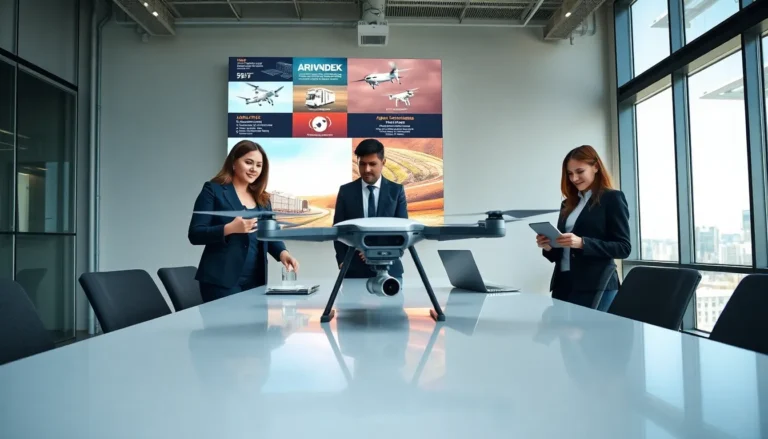Table of Contents
ToggleIn a world where even your coffee maker might have a personality, fleet robotics is taking the spotlight. Imagine a squad of robots zipping around, coordinating like a well-rehearsed dance troupe, all while managing tasks that would make even the most seasoned human worker raise an eyebrow. These tech-savvy marvels are revolutionizing industries, transforming logistics, and making the mundane seem downright magical.
Gone are the days when fleets were just a bunch of vehicles stuck in traffic. Now, with fleet robotics, efficiency is the name of the game. Picture autonomous drones delivering your packages faster than you can say “where’s my order?” It’s not just about speed; it’s about precision, safety, and a sprinkle of futuristic flair. Buckle up as we dive into the world of fleet robotics and discover how it’s reshaping the way we think about transportation and automation.
Overview of Fleet Robotics
Fleet robotics refers to a network of autonomous robots working together to accomplish tasks effectively. These robots communicate with each other, allowing for real-time decision-making and coordination. Operations typically include tasks such as delivery, transportation, and warehouse management.
The technology driving fleet robotics integrates artificial intelligence, machine learning, and advanced sensors. These components enable robots to navigate complex environments and perform efficiently. They adapt to changing circumstances, ensuring optimal performance across various settings.
Industries leveraging fleet robotics experience significant improvements in productivity. Logistics companies report faster delivery times due to the automation of vehicle fleets. These systems allow for precise routing, minimizing delays and increasing overall efficiency.
Safety remains a crucial aspect of fleet robotics. Many systems incorporate collision avoidance algorithms, enhancing operational safety for both robots and humans. By minimizing accidents, these technologies foster safer working environments.
Costs may decline with the deployment of fleet robotics. Reduced labor expenses and lower operational costs contribute to overall savings. As investment in these technologies increases, companies can expect higher returns through streamlined operations.
Examples of fleet robotics in action abound. Companies like Amazon use autonomous delivery drones for package transport. Similarly, warehouse automation systems employ robotic retrieval and sorting solutions which further illustrate the capabilities of fleet robotics.
The future looks promising for fleet robotics. Enhancements in sensor technology and AI will likely result in even more advanced systems. As industries continue to adopt these innovations, the landscape of logistics and transportation will drastically evolve.
Applications of Fleet Robotics
Fleet robotics significantly enhances operational efficiency across multiple sectors. These advanced systems automate tasks and improve productivity, allowing industries to adopt innovative solutions.
Industrial Use Cases
Manufacturing plants utilize fleet robotics for assembly line efficiency. Autonomous mobile robots transport materials and components to different production areas, reducing the time workers spend in transit. Warehouse management benefits from robotic picking systems that retrieve items swiftly, which optimizes space usage. Additionally, distribution centers implement fleet robotics for inventory management and order fulfillment, leading to faster processing and reduced human error. These applications contribute to substantial cost savings and streamlined operations across various industrial environments.
Agricultural Innovations
Agriculture increasingly leverages fleet robotics for crop management. Autonomous tractors and drones monitor fields, applying fertilizers and pesticides precisely where needed. Robots also assist in planting seeds and harvesting crops, enhancing yield while minimizing resource use. Fleet robots work in coordinated teams, which allows for efficient data collection on soil conditions and plant health. This technology helps farmers make informed decisions, improving overall agricultural productivity while ensuring sustainability in operations.
Benefits of Fleet Robotics
Fleet robotics offers numerous advantages across various industries, particularly in logistics and transportation. Enhanced coordination and integration lead to improved outcomes in efficiency and cost-effectiveness.
Increased Efficiency
Enhanced workflow arises from the coordinated efforts of multiple robots working together. Fleet robotics streamlines processes, leading to faster and more accurate deliveries. Real-time data sharing allows robots to adapt quickly to changes in their environments. Tasks that traditionally required significant human intervention can now occur seamlessly with minimal downtime. Companies utilizing fleet robotics report considerable increases in operational speeds, enabling them to meet customer demands effectively. By optimizing routes and reducing idle time, these systems significantly boost overall productivity.
Cost Reduction
Cost savings represent a primary benefit of implementing fleet robotics. Reductions in labor expenses occur as autonomous robots perform tasks previously handled by personnel. Significant reductions in operational costs stem from increased efficiency and minimized errors. Fleet robotics also leads to lower maintenance costs due to their automated processes, which enhance equipment longevity. Data indicates that industries adopting robotic fleets can witness ROI within a short period. Overall, the financial benefits of fleet robotics contribute to more sustainable business practices and long-term growth potential.
Challenges in Fleet Robotics
Fleet robotics faces several challenges that impact its widespread implementation. Key obstacles include technical limitations and regulatory hurdles.
Technical Limitations
Technical limitations hinder fleet robotics’ potential. Many robots struggle with complex environments, navigating obstacles or adapting to dynamic conditions. Sensors may not always provide accurate data, leading to suboptimal decision-making. Communication between robots can also be inconsistent, resulting in coordination issues that affect performance. Limited battery life restricts operational periods, forcing fleets to recharge frequently. Additionally, reliance on advanced algorithms increases the risk of software failures, which can disrupt operations. Improvements in AI and sensor technology are crucial for overcoming these limitations.
Regulatory Hurdles
Regulatory hurdles create barriers for fleet robotics adoption. Different regions enforce varying rules governing autonomous vehicle operations, complicating deployment across jurisdictions. Compliance with safety standards and guidelines often requires extensive testing and data collection. Privacy concerns arise with robots collecting data in public spaces, necessitating legal frameworks to protect sensitive information. Limited infrastructure to support autonomous operations adds another layer of complexity. A coordinated effort among industry stakeholders is essential to advocate for clearer regulations that facilitate fleet robotics integration while addressing public safety and privacy.
Future Trends in Fleet Robotics
Advancements in technology will shape the future of fleet robotics. Predictive analytics will enable smarter decision-making processes, allowing autonomous systems to anticipate needs and respond effectively. Increased integration of machine learning algorithms helps systems learn from previous operations, enhancing overall productivity.
Enhanced communication protocols will drive coordination among robots, leading to smoother operations in complex environments. Additionally, developments in sensor technology will improve navigation capabilities, enabling robots to navigate dynamic settings with ease. Businesses will likely benefit from adopting AI-driven data analysis tools, streamlining processes and enhancing operational efficiency.
Greater emphasis on sustainability is expected to drive innovations in fleet robotics. Energy-efficient robots will minimize environmental impact, aligning with corporate sustainability goals. Moreover, collaboration between various industries may emerge, with agri-tech partnering with logistics firms to create holistic robotic solutions.
Performance metrics will also undergo refinement as industries seek to measure the effectiveness of robotic fleets. Key performance indicators will then focus on speed, accuracy, and cost savings to evaluate overall impact. Continuous monitoring of these metrics may provide valuable insights, enabling companies to adapt strategies in real-time.
Legislative changes will likely pave the way for widespread fleet robotics adoption. Policymakers may consider updated regulations that balance innovation with safety and privacy concerns. Industry coalitions will advocate for these changes, fostering an environment conducive to technological advancements.
Ongoing research and development initiatives will emerge, addressing existing challenges while fostering a culture of innovation. The convergence of robotics and Internet of Things technology will create interconnected systems, elevating fleet operations to new heights. As these trends unfold, the landscape of logistics, transportation, and agriculture will transform, powered by fleet robotics’ potential.
Fleet robotics is poised to redefine the landscape of various industries by enhancing efficiency and safety. As autonomous systems continue to evolve they promise significant cost savings and productivity gains. The integration of advanced technologies like AI and machine learning will further streamline operations and improve decision-making capabilities.
While challenges remain in terms of regulations and technical limitations collaboration within the industry will be crucial for overcoming these hurdles. The future of fleet robotics looks bright with ongoing innovations driving sustainability and performance improvements. As organizations embrace this technology they’ll not only enhance their operational capabilities but also contribute to a more efficient and eco-friendly future.






